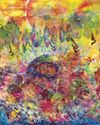
Conceptual art is art where the artistic aspect is considered to reside in the concept alone, not in any of its sensory qualities (if it has any). For many years now conceptual art has formed the dominant strand of contemporary art – at least according to that network of galleries, critics and collectors who decide what should be considered important among the range of current artistic production. Now, however, it’s beginning to be displaced by a new contender for our attention, which I propose to call ‘social art’. I’ll explain what I mean by this soon. First, I want to consider the general question of how specific art-forms rise to prominence.
The Institutional Theory of Art
Philosophers have asked the question ‘What is Art?’ as far back as Plato in the fourth century BCE. But the question has seemed to acquire a new urgency in response to the bewildering diversity of objects and activities which in the twentieth century have been claimed to have the status of ‘art’.
This story is from the April/May 2021 edition of Philosophy Now.
Start your 7-day Magzter GOLD free trial to access thousands of curated premium stories, and 9,000+ magazines and newspapers.
Already a subscriber ? Sign In
This story is from the April/May 2021 edition of Philosophy Now.
Start your 7-day Magzter GOLD free trial to access thousands of curated premium stories, and 9,000+ magazines and newspapers.
Already a subscriber? Sign In

Metaphors & Creativity
Ignacio Gonzalez-Martinez has a flash of inspiration about the role metaphors play in creative thought.

Medieval Islam & the Nature of God
Musa Mumtaz meditates on two maverick medieval Muslim metaphysicians.

Robert Stern
talks with AmirAli Maleki about philosophy in general, and Kant and Hegel in particular.

Volney (1757-1820)
John P. Irish travels the path of a revolutionary mind.

IT'S A WONDERFUL LIFE
Becky Lee Meadows considers questions of guilt, innocence, and despair in this classic Christmas movie.

"I refute it thus"
Raymond Tallis kicks immaterialism into touch.

Cave Girl Principles
Larry Chan takes us back to the dawn of thought.

A God of Limited Power
Philip Goff grasps hold of the problem of evil and comes up with a novel solution.

A Critique of Pure Atheism
Andrew Likoudis questions the basis of some popular atheist arguments.

Exploring Atheism
Amrit Pathak gives us a run-down of the foundations of modern atheism.